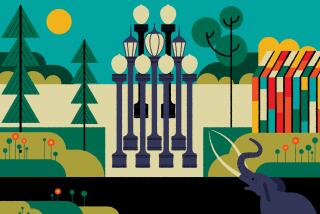Mask Marvels : ‘Movable museum’ strives to unveil an art in hands-on school project
- Share via
Who was that masked child?
Starting Monday, elementary schoolchildren from Los Angeles County will not only be wearing masks, but will be creating them, studying them and learning about the cultures from which they originate. “Movable Museum: Behind the Mask” is a new, hands-on project co-sponsored by the Craft and Folk Art Museum and Los Angeles Unified School District.
In the past, the museum’s biannual Festival of Masks (held last October) has been a public celebration featuring vendors and mask-makers, demonstrating everything from Italian leather masks to works made with the help of a photocopy machine. Now Janet Marcus, the museum’s educational curator, hopes to take the process further. Her vision is for a school program that not only explores mask art, but opens the door to related studies of geography, language, natural science and history.
Because of a shortage of school-sponsored transportation, “kids can’t often get to the museum,” she said. “So we wanted to develop something to bring to them. These masks are used in different contexts, rituals and celebrations, with costumes and musical instruments. Also, I wanted them to get away from always associating masks with Halloween. I wanted them to see that they’re used in every corner of the world--for specific purposes. And because of the large diversity of ethnic groups in Los Angeles, this is a way to teach kids about their own culture.”
The four representative mask-cultures chosen for this month’s program are Nigerian, American Indian, Balinese and Guatemalan the latter the subject of an exhibit at the Craft and Folk Art Museum, across the street from the Los Angeles County Museum of Art.
In November, Marcus held a workshop for 60 area teachers, who learned which substances--such as plaster-gauze bandage and papier-mache--would be best suited to classroom mask-making. A puppeteer talked about movement and performance, and mask-makers taught the art of making clay, wire, paper and puppet masks.
Marcus believes the teachers’ training--and the hands-on approach to art education--will be a springboard for students. “Reading and hearing are important aspects of learning,” she said. “But another important aspect is actually seeing and doing .”
Marcus believes masks are rich with cultural and sociological information.
“Often when kids look at an object, there’s a remembrance of something, a connection with their heritage. It gives them a sense of time and what the culture’s all about. It also helps in terms of better understanding of each other.”
The elementary schools that will participate in the 1989 “Movable Museum” are Brentwood Science Magnet in West Los Angeles, Blythe Street Elementary School in Reseda, San Pasqual Elementary School in South Pasadena, Amestoy School in Gardena and 75th Street Elementary School in South-Central Los Angeles.
On Day 1 of the program (there will be five sessions over a 5-week period) children will be introduced to masks, their use and background.
At the second session, students will visit the museum. “The third and fourth week, I’ve hired artists and mask-makers for two 2-hour projects. Onochie Chukwurah is a Nigerian storyteller who’ll tell folk tales and show examples of wooden and paper masks. And on the fifth day, I’ve hired several mask-dancers to perform.”
Marcus, who’s marking her seventh anniversary at the museum, comes to the arts-education world via painting, which she studied at UC Berkeley. It was there that she began working in a museum.
“I was interested in how one makes art and how one interprets it,” she said. “It was interesting to say, ‘OK, what audience is coming to this museum?’ A couple of years ago, we had a puzzle show here. This man in Los Angeles had collected 10,000 puzzles. For the exhibit--which is still traveling around the world--we used 800 of them--interactive puzzles, enlargements of small puzzles, dexterity puzzle, wire puzzles, rope puzzles. We had people coming who weren’t craftsmen, but anthropologists, scientists. It became something for the community.”
More to Read
The biggest entertainment stories
Get our big stories about Hollywood, film, television, music, arts, culture and more right in your inbox as soon as they publish.
You may occasionally receive promotional content from the Los Angeles Times.










